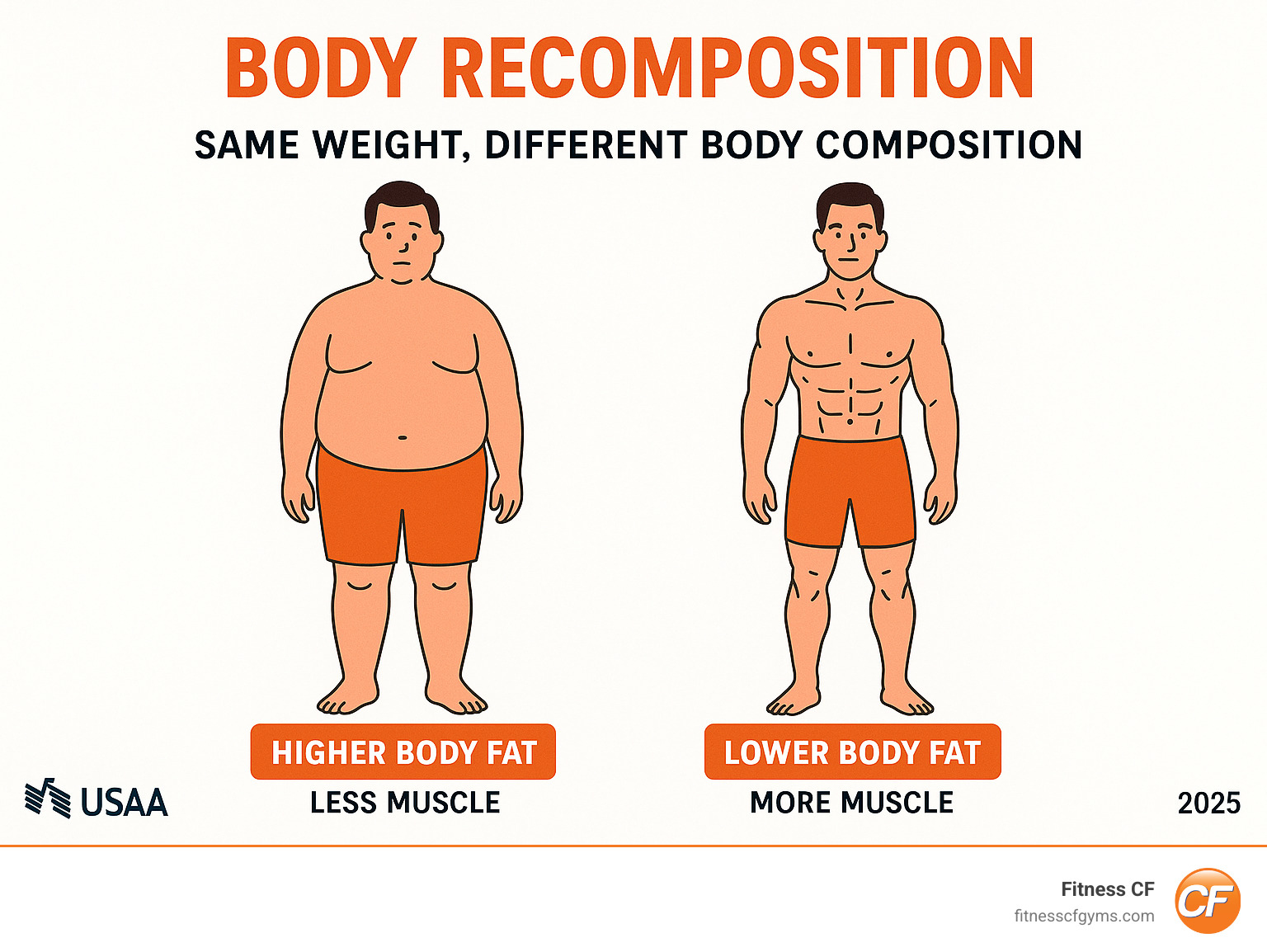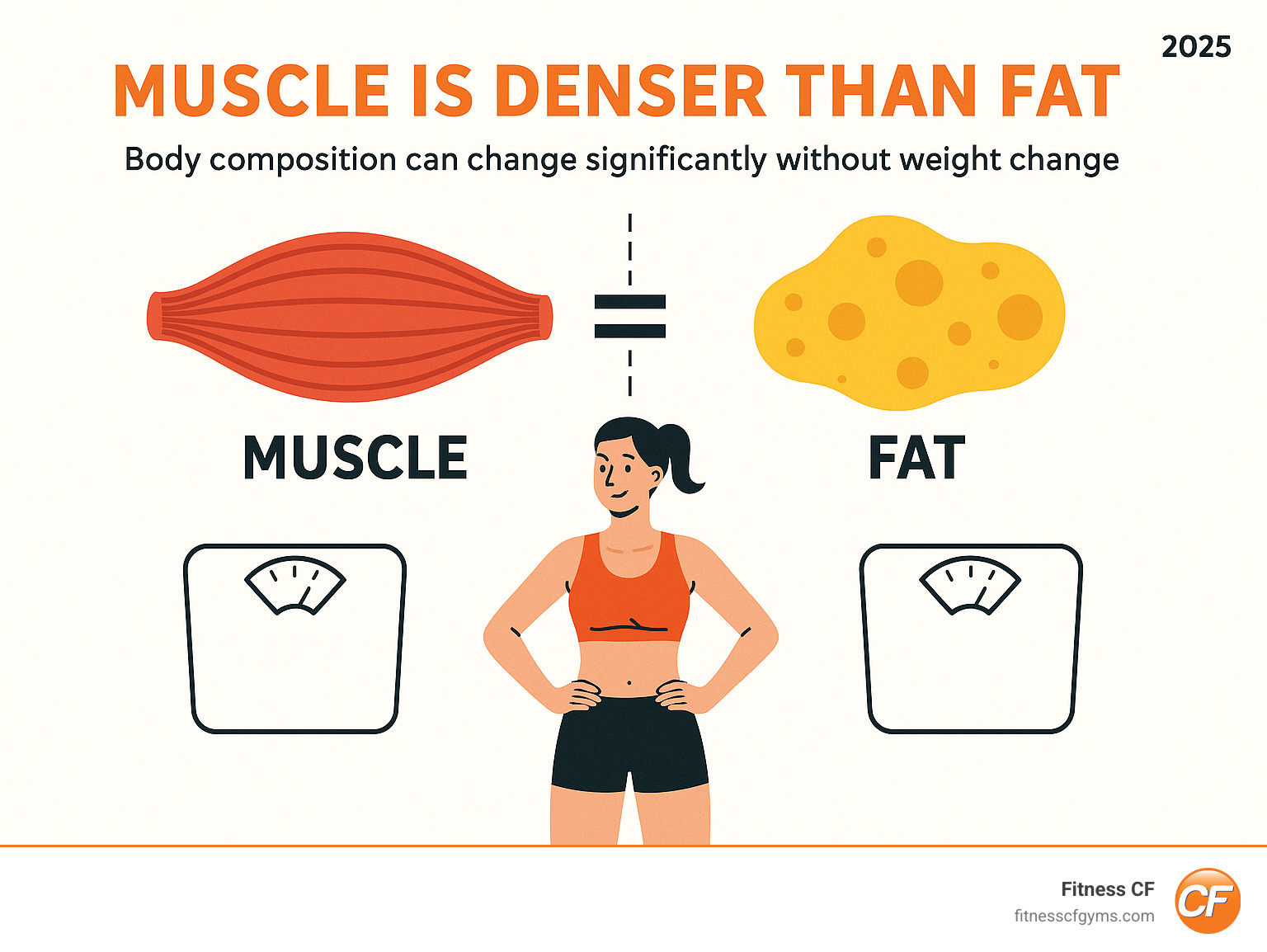Open uping Your Potential: The Body Recomposition Guide
Many people believe you must choose between losing fat or gaining muscle. But what if you could do both? To how to lose fat and gain muscle simultaneously, focus on these key areas:
- Calorie Management: Eat slightly fewer calories than you burn.
- Protein Power: Consume plenty of protein to build and keep muscle.
- Strength Training: Lift weights regularly to challenge your muscles.
- Rest & Recovery: Get enough sleep to allow your body to repair and grow.
This process is called body recomposition. It means changing your body’s shape by reducing fat and building muscle at the same time. You’re not just losing weight; you’re changing your body’s makeup.
It’s a tough goal, requiring discipline and knowledge. But it is absolutely possible.
Body recomposition is especially achievable for beginners or those getting back into fitness. If you have higher body fat to start, you might see faster, noticeable changes. This guide will show you how to do it.
With over 40 years in the fitness industry, I’m Pleasant Lewis. I’ve spent my career helping people like you steer the journey of how to lose fat and gain muscle through effective and sustainable methods.

The Science of How to Lose Fat and Gain Muscle
The idea of simultaneously losing fat and gaining muscle might sound like a paradox. After all, traditional wisdom suggests you need a calorie deficit to lose fat and a calorie surplus to build muscle. This is the “calorie conundrum” at the heart of body recomposition. However, our bodies are remarkably adaptable, and with the right strategy, we can achieve this seemingly contradictory feat.
The Calorie Conundrum: Finding Your Sweet Spot
At its core, losing fat requires a calorie deficit – consuming fewer calories than your body burns. For sustainable and healthy weight loss, aiming for a deficit of approximately 500 calories per day can lead to about a pound of fat loss per week. This approach helps ensure that your body taps into its fat stores for energy.
However, building muscle typically requires a calorie surplus – providing your body with more energy than it needs, so it has the building blocks for new tissue. So, how do we reconcile these two opposing requirements for body recomposition? The key lies in finding a “sweet spot” that allows your body to pull energy from existing fat stores to fuel muscle growth, even while in a slight overall deficit.
Aggressive calorie deficits can be counterproductive for muscle gain, as they risk muscle loss alongside fat. Research indicates that when you lose weight, a quarter or more of that loss can come from fat-free mass (muscle). This is why a moderate approach is crucial.
First, we need to understand our maintenance calories – the amount of energy our body needs to maintain its current weight. Online tools, like the Mayo Clinic calorie calculator, can help us estimate this. Once we have our maintenance number, we can implement strategies like calorie cycling. This involves strategically adjusting your calorie intake based on your activity level for the day. For instance:
- On days with intense strength training, you might aim for a slight calorie surplus (5-15% above maintenance) to support muscle repair and growth.
- On cardio days, consume calories roughly equal to your maintenance needs.
- On rest days, a slight calorie deficit (5-10% below maintenance) can help promote fat loss.
This nuanced approach allows us to provide enough energy for muscle building on training days while still encouraging fat loss on recovery and less active days. It’s about being smart with our fuel, ensuring our body has what it needs without overdoing it.
Why Protein is Your Most Valuable Player
When it comes to body recomposition, protein isn’t just important; it’s your most valuable player. This macronutrient is fundamental for muscle repair, growth, and preservation, especially when you’re in a calorie deficit. Think of protein as the bricks for building your physique – you can’t construct a strong structure without enough of them.
Protein plays several crucial roles:
- Muscle Repair and Growth: After a tough workout, your muscle fibers experience micro-tears. Protein provides the amino acids necessary to repair these tears and build new, stronger muscle tissue. This process is called muscle protein synthesis.
- Satiety and Fat Loss: Protein is incredibly satiating, meaning it helps you feel fuller for longer. This is a huge advantage when you’re aiming for a calorie deficit, as it can reduce cravings and prevent overeating.
- Preserving Lean Mass: When you’re losing fat, there’s always a risk of losing muscle alongside it. A high protein intake helps signal to your body that it needs to hold onto its precious muscle mass, even as it burns fat for energy. Research has shown that a high-protein diet can help preserve lean body mass while in a calorie deficit. For more on this, check out this evidence that high-protein diets preserve muscle mass in a deficit.
So, how much protein do you need? While the Recommended Dietary Allowance (RDA) for protein is 0.8 grams per kilogram of body weight, for active individuals looking to build muscle and lose fat, experts recommend significantly higher amounts. Aim for at least 1 gram of protein per pound of your body weight (or approximately 3 grams per kilogram of body weight). This can also translate to a minimum of 35% of your daily calorie needs coming from protein.
It’s also beneficial to distribute your protein intake evenly throughout the day, rather than trying to consume it all in one or two meals. This ensures a steady supply of amino acids for continuous muscle protein synthesis.
Here are some excellent sources of high-protein foods to include in your diet:
- Chicken breast
- Lean beef
- Eggs
- Cottage cheese
- Lentils
- Fish (especially fatty fish like salmon, herring, and sardines for added healthy fats)
- Dairy products
- Poultry
- Legumes
- Soy products
- Nuts and seeds
For a more comprehensive guide on protein-rich foods, explore our article on Lean Muscle Diet: Your Complete Guide to Foods That Deliver.
Your Training Blueprint for a New Physique
While nutrition lays the groundwork, your training strategy is where the magic truly happens for building muscle and shaping your physique. It’s not just about burning calories; it’s about stimulating your muscles to grow stronger and more defined.
The Foundation: Strength Training for Muscle Growth
Strength training is the cornerstone of any body recomposition plan. It’s the primary stimulus for muscle growth, which in turn boosts your metabolism and helps you burn more fat.

Here’s why it’s so vital:
- Progressive Overload: To continuously build muscle, you must consistently challenge your muscles more than they’re accustomed to. This principle, known as progressive overload, means gradually increasing the weight, repetitions, or sets over time. We recommend slowly increasing your weights by no more than 10% each week to allow your body to adapt and reduce injury risk.
- Compound Exercises: Focus on multi-joint, compound exercises like squats, deadlifts, bench presses, overhead presses, and rows. These movements engage multiple muscle groups simultaneously, leading to greater muscle activation and calorie expenditure during and after your workout.
- Muscle Micro-tears and Repair: When you lift weights, you create tiny micro-tears in your muscle fibers. During recovery, with adequate protein and rest, your body repairs these tears, making the muscle fibers thicker and stronger. This is how muscle growth (hypertrophy) occurs.
- Metabolic Boost: Muscle tissue is metabolically active, meaning it burns more calories at rest than fat tissue. By building more muscle, you effectively increase your resting metabolism, turning your body into a more efficient fat-burning machine 24/7.
- Overall Health Benefits: Beyond aesthetics, strength training offers profound health benefits. Healthy adults who engaged in full-body resistance training for at least four weeks lost 1.4% of their body fat compared with adults who didn’t exercise. Furthermore, strength training reduces the risk of death from all causes by 10 to 17%. The Centers for Disease Control and Prevention (CDC) recommends engaging in exercises that strengthen all major muscle groups at least two days each week.
For a deeper dive into strength training and its benefits, explore our article What is Strength Training and What Are Its Benefits?. The evidence is clear: Strength training reduces all-cause mortality risk, making it a powerful tool for longevity and overall well-being.
The Accelerator: Smart Cardio for Fat Loss
While strength training is your foundation, smart cardio acts as an accelerator for fat loss, helping you create that crucial calorie deficit. The CDC recommends devoting at least 150 minutes a week to moderate-intensity cardio exercise.
When integrating cardio into your body recomposition plan, consider the type and intensity:
- High-Intensity Interval Training (HIIT): This involves short bursts of intense exercise followed by brief recovery periods. HIIT is incredibly effective for burning calories in a shorter amount of time and can boost your metabolism for hours afterward. Some research suggests HIIT can lead to significant fat loss. Learn more about The Benefits of High-Intensity Interval Training (HIIT) for Weight Loss.
- Low-Intensity Steady State (LISS): This involves longer durations of moderate-intensity activity, like brisk walking, jogging, or cycling. LISS is excellent for burning fat without overly taxing your recovery or interfering with muscle gains. For some, especially those who are already lean or focused heavily on muscle growth, LISS can be preferable as it causes less overall systemic stress compared to HIIT.
The key is to use cardio as a tool to support your calorie deficit without hindering your strength training recovery. While cardio burns more calories during the activity itself, resistance training helps you burn more calories at rest by building muscle. It’s not a matter of one being “better” than the other, but rather how they complement each other. For a detailed comparison, see Strength Training vs. Cardio: Which is Better for Weight Loss?.
The best approach is one that you can stick with consistently. Whether it’s a mix of both or a preference for one, ensure your cardio supports your overall calorie goals and doesn’t compromise your strength training efforts.
Lifestyle Factors: The Keys to Open uping Your Potential
Achieving how to lose fat and gain muscle isn’t just about what you do in the gym or how perfectly you track your meals. Your daily habits, especially how much you sleep and how you measure your progress, are incredibly important. They truly help you open up your full potential.
Why Sleep is a Non-Negotiable for How to Lose Fat and Gain Muscle
We often don’t give sleep the credit it deserves, but it’s truly the most powerful recovery tool our bodies have. When you’re working hard to build muscle and lose fat, sleep is where the real magic happens.
Think about it: while you’re in a deep sleep, your body gets busy! It releases growth hormone, which is super important for repairing your muscles and helping them grow bigger and stronger. On the flip side, not getting enough sleep can mess with your hormones. It can raise cortisol, a stress hormone that encourages fat storage and can even break down muscle. It also lowers testosterone, which is key for building muscle. Plus, lack of sleep can reduce the release of special proteins called cytokines, which are essential for muscle protein synthesis. Simply put, it makes it much harder for your body to recover and build muscle.
Most adults need about seven to nine hours of quality sleep each night. If you’re an athlete pushing your limits, you might even need closer to ten! To make sleep a priority, create a peaceful, dark space in your bedroom. Try to avoid screens before bed, and stick to a regular sleep schedule, even on weekends. Think of sleep as your body’s dedicated time to rebuild, repair, and get ready for the next day’s workouts and challenges. Without it, you’re basically undoing all the amazing work you’re putting in at the gym and in the kitchen. To learn more about the science behind sleep and muscle growth, check out this research on sleep deprivation and muscle protein synthesis.
How to Measure Progress Beyond the Scale
When your goal is body recomposition, that number on the bathroom scale can be a bit of a trickster. It doesn’t tell you the whole story because it can’t tell the difference between fat and muscle. Since muscle is denser than fat, your weight might stay the same, or even go up a little, while your body is actually getting much leaner and stronger! This is why we often suggest our members “ditch the scale” as their main way to check progress.

Instead, we recommend using a few different ways to track your amazing change:
- Progress Photos: Snap pictures of yourself (front, back, and side) every 4-6 weeks. Make sure you use the same lighting and wear similar clothes each time. These visual comparisons are incredibly powerful and will show changes the scale simply can’t.
- Body Measurements: Grab a tape measure and track the circumference of your waist, hips, chest, arms, and thighs. Losing inches, especially around your waist, is a super clear sign that you’re losing fat.
- How Your Clothes Fit: This is a simple but very effective way to see changes. If your clothes feel looser, or you’re able to fit into a smaller size, it’s a sure sign your body composition is improving.
- Tracking Strength Gains: Are you lifting heavier weights? Can you do more repetitions? Is your form getting better? These are direct signs of muscle growth and increased strength, which are central to body recomposition. Keeping a workout journal is a fantastic way to see this progress.
- Body Fat Percentage: If you have access to it, getting regular body fat percentage assessments (like via a DEXA scan or bioelectrical impedance) can give you a very accurate picture of your fat-to-muscle ratio.
The real goal is to transform your physique, not just to change a number on a scale. Focusing on these different ways to measure progress will give you a more accurate, motivating, and complete view of your how to lose fat and gain muscle journey. As we mentioned, muscle is denser than fat, so don’t let the scale mislead you!
Frequently Asked Questions about Body Recomposition
We know you’ve got questions, and that’s fantastic! Asking questions is the first step to truly understanding your body and your fitness journey. Body recomposition is a nuanced topic, but by tackling some common queries, we can help clarify your path forward.
How long does it take to see results from body recomposition?
This is one of the most common questions we hear, and the honest answer is: it’s a marathon, not a sprint! Seeing significant results from body recomposition is a slow and steady process that takes time and consistent effort. You’re asking your body to do two challenging, yet incredibly rewarding, things simultaneously: shed fat and build muscle. This isn’t a quick fix or a fad diet; it’s a sustainable lifestyle change that truly transforms you from the inside out.
While you might start to notice subtle changes in how your clothes fit, or feel a boost in your energy levels within 4-6 weeks, more significant, visible results typically take 8-12 weeks for beginners. If you’re someone who’s been training for a while, the changes might be a bit slower, but just as meaningful. The most important thing is to remember that consistency in your nutrition, training, and recovery is the absolute key. Don’t get discouraged if the scale doesn’t move much initially; remember to focus on the other amazing progress metrics we talked about earlier. Patience and perseverance will absolutely pay off!
Can I eat whatever I want as long as I hit my protein and calorie goals?
This is a fun one, and while it’s tempting to think so, the simple answer is: no, not really. While hitting your protein and calorie targets is incredibly crucial for how to lose fat and gain muscle, the quality of your diet matters immensely. Think of your body like a high-performance car – you wouldn’t put just any fuel in it, right? Your body needs top-notch fuel too!
Focusing on whole, unprocessed foods like lean meats, fresh fruits, vibrant vegetables, hearty whole grains, and healthy fats provides your body with all the essential micronutrients (like vitamins and minerals) it needs for optimal functioning, speedy recovery, and overall health. These nutrient-dense foods also tend to be much more satiating, meaning they help you feel fuller for longer. For example, 200 calories of crunchy broccoli will keep you feeling satisfied much longer than 200 calories of a highly processed snack.
Relying heavily on processed foods, even if they technically fit your calorie and protein macros, can lead to nutrient deficiencies, sluggish energy levels, and increased cravings. This can make your body recomposition journey much harder than it needs to be. Your body truly needs quality fuel to perform optimally and build that beautiful new muscle tissue. For more insights on combining diet and exercise effectively, explore our guide on Effective Weight Loss Strategies: Combining Exercise and Nutrition.
Is it better to focus on losing fat first, then building muscle?
For many years, the conventional wisdom in the fitness world was to “bulk” (eating in a calorie surplus to gain muscle, often with some fat gain) and then “cut” (eating in a calorie deficit to lose fat, accepting some potential muscle loss). This phased approach is still highly effective, especially for very lean individuals or competitive bodybuilders looking to maximize both muscle gain and fat loss in distinct, intense phases.
However, body recomposition offers a fantastic alternative, especially for certain individuals:
- Beginners: If you’re just starting your strength training journey, your body is incredibly responsive to new stimuli. You can often build muscle and lose fat simultaneously quite effectively, experiencing what we call “newbie gains.”
- Detrained Individuals: If you’re returning to training after a break, your body has a “muscle memory” effect. This makes it easier to regain lost muscle mass while shedding any unwanted fat you might have accumulated.
- Individuals with Higher Body Fat: If you have significant fat stores, your body can more readily tap into these reserves for energy. This means you can fuel muscle growth even while maintaining a slight calorie deficit, making how to lose fat and gain muscle at the same time a very real possibility.
For these groups, body recomposition can be a highly efficient and incredibly motivating strategy, as you get to see simultaneous improvements in both muscle and leanness. For others, particularly those who are already quite lean and experienced, the phased “bulk and cut” approach might still yield faster and more dramatic results for each specific goal. The “best” approach truly depends on your starting point, your experience level, and your personal preferences. Regardless of your chosen path, avoiding common pitfalls is key to success. Learn more about 11 Common Muscle Building Mistakes and How to Avoid Them.
Your Path to a Stronger, Leaner You
Starting on the journey of how to lose fat and gain muscle simultaneously isn’t just about achieving a better-looking physique—it’s about embracing a sustainable lifestyle change that will transform your entire well-being. This path requires consistency over perfection, and that’s actually good news. You don’t need to be perfect every single day; you just need to show up consistently and trust the process.
The beautiful thing about body recomposition is that the benefits ripple far beyond what you see in the mirror. When you commit to this approach, you’re investing in a healthier, stronger version of yourself that will serve you for decades to come.
Improved metabolic health becomes one of your greatest rewards. As you build lean muscle mass, your body becomes a more efficient calorie-burning machine, even while you’re sleeping. This increased muscle tissue improves your insulin sensitivity and helps regulate blood sugar levels, creating a foundation for long-term health that extends well beyond your fitness goals.
You’ll find increased strength and functional ability that makes everyday life easier and more enjoyable. Simple tasks like carrying groceries, playing with your kids, or climbing stairs become effortless. Your body moves with more confidence and grace, and you’ll be amazed at how this physical strength translates into mental resilience.
The boost in confidence that comes from watching your body transform is truly remarkable. There’s something powerful about setting a challenging goal and achieving it through your own dedication and hard work. This confidence doesn’t just stay in the gym—it flows into every area of your life, from your career to your relationships.
Perhaps most importantly, you’re dramatically reducing your risk of chronic diseases. The combination of strength training, improved body composition, and healthy eating habits creates a powerful defense against heart disease, type 2 diabetes, and other conditions that affect millions of people. Strength training alone can reduce your risk of death from all causes by 10 to 17%—that’s a pretty incredible return on investment.
Your bones will thank you too. The weight-bearing exercises that build muscle also strengthen your skeletal system, improving bone density and reducing your risk of osteoporosis as you age. You’re literally building a stronger foundation for your future self.
While this guide provides you with a solid roadmap, you don’t have to steer this journey alone. Sometimes seeking professional guidance can accelerate your progress and help you avoid common pitfalls.
Always consult with a healthcare provider before starting any new diet or exercise program, especially if you have underlying health conditions. A registered dietitian can help create personalized nutrition plans that align with your specific goals and dietary preferences. And a certified personal trainer can design effective workout routines, ensure you’re using proper form, and provide the motivation and accountability that makes all the difference.
At Fitness CF, we understand that every person’s journey is unique. Our expert personal trainers are passionate about helping you achieve your body recomposition goals through safe, effective programs custom specifically to your needs. We believe in empowering our members with both the knowledge and support to build a stronger, leaner, and healthier version of themselves.
Your change is waiting for you. It won’t always be easy, but it will absolutely be worth it. The person you’ll become through this process—stronger, healthier, more confident—is the greatest gift you can give yourself.









